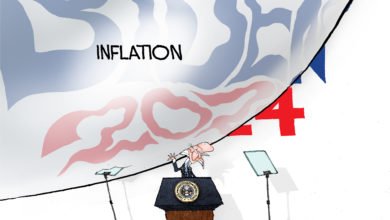1973 War Powers Act
The War Powers Act of 1973
Public Law 93-148 93rd Congress, H. J. Res. 542 November 7, 1973
Joint Resolution : Concerning the war powers of Congress and the President.
Resolved by the Senate and the House of Representatives of the United States
of America in Congress assembled,
SHORT TITLE
SECTION 1.
- This joint resolution may be cited as the “War Powers Resolution”.
PURPOSE AND POLICY
SEC. 2. (a)
It is the purpose of this joint resolution to fulfill the intent of the
framers of the Constitution of the United States and insure that the collective
judgement of both the Congress and the President will apply to the introduction
of United States Armed Forces into hostilities, or into situations where
imminent involvement in hostilities is clearly indicate by the circumstances,
and to the continued use of such forces in hostilities or in such situations.
- SEC. 2. (b)
- Under article I, section 8, of the Constitution, it is specifically provided
that the Congress shall have the power to make all laws necessary and proper for
carrying into execution, not only its own powers but also all other powers
vested by the Constitution in the Government of the United States, or in any
department or officer thereof. - SEC. 2. (c)
- The constitutional powers of the President as Commander-in-Chief to
introduce United States Armed Forces into hostilities, or into situations where
imminent involvement in hostilities is clearly indicated by the circumstances,
are exercised only pursuant to (1) a declaration of war, (2) specific statutory
authorization, or (3) a national emergency created by attack upon the United
States, its territories or possessions, or its armed forces.
CONSULTATION
SEC. 3.
- The President in every possible instance shall consult with Congress before
introducing United States Armed Forces into hostilities or into situation where
imminent involvement in hostilities is clearly indicated by the circumstances,
and after every such introduction shall consult regularly with the Congress
until United States Armed Forces are no longer engaged in hostilities or have
been removed from such situations.
REPORTING
Sec. 4. (a)
- In the absence of a declaration of war, in any case in which United States
Armed Forces are introduced– - (1)
- into hostilities or into situations where imminent involvement in
hostilities is clearly indicated by the circumstances; - (2)
- into the territory, airspace or waters of a foreign nation, while equipped
for combat, except for deployments which relate solely to supply, replacement,
repair, or training of such forces; or - (3)
(A) - the circumstances necessitating the introduction of United States Armed
Forces; - (B)
- the constitutional and legislative authority under which such introduction
took place; and - (C)
- the estimated scope and duration of the hostilities or involvement.
- Sec. 4. (b)
- The President shall provide such other information as the Congress may
request in the fulfillment of its constitutional responsibilities with respect
to committing the Nation to war and to the use of United States Armed Forces
abroad. - Sec. 4. (c)
- Whenever United States Armed Forces are introduced into hostilities or into
any situation described in subsection (a) of this section, the President shall,
so long as such armed forces continue to be engaged in such hostilities or
situation, report to the Congress periodically on the status of such hostilities
or situation as well as on the scope and duration of such hostilities or
situation, but in no event shall he report to the Congress less often than once
every six months.
CONGRESSIONAL ACTION
SEC. 5. (a)
- Each report submitted pursuant to section 4(a)(1) shall be transmitted to
the Speaker of the House of Representatives and to the President pro tempore of
the Senate on the same calendar day. Each report so transmitted shall be
referred to the Committee on Foreign Affairs of the House of Representatives and
to the Committee on Foreign Relations of the Senate for appropriate action. If,
when the report is transmitted, the Congress has adjourned sine die or has
adjourned for any period in excess of three calendar days, the Speaker of the
House of Representatives and the President pro tempore of the Senate, if they
deem it advisable (or if petitioned by at least 30 percent of the membership of
their respective Houses) shall jointly request the President to convene Congress
in order that it may consider the report and take appropriate action pursuant to
this section. - SEC. 5. (b)
- Within sixty calendar days after a report is submitted or is
required to be submitted pursuant to section 4(a)(1), whichever is earlier, the
President shall terminate any use of United States Armed Forces with respect to
which such report was submitted (or required to be submitted), unless the
Congress (1) has declared war or has enacted a specific authorization for such
use of United States Armed Forces, (2) has extended by law such sixty-day
period, or (3) is physically unable to meet as a result of an armed attack upon
the United States. Such sixty-day period shall be extended for not more than an
additional thirty days if the President determines and certifies to the Congress
in writing that unavoidable military necessity respecting the safety of United
States Armed Forces requires the continued use of such armed forces in the
course of bringing about a prompt removal of such forces. - SEC. 5. (c)
- Notwithstanding subsection (b), at any time that United States Armed Forces
are engaged in hostilities outside the territory of the United States, its
possessions and territories without a declaration of war or specific statutory
authorization, such forces shall be removed by the President if the Congress so
directs by concurrent resolution.
CONGRESSIONAL PRIORITY PROCEDURES FOR JOINT RESOLUTION OR BILL
SEC. 6. (a)
- Any joint resolution or bill introduced pursuant to section 5(b) at least
thirty calendar days before the expiration of the sixty-day period specified in
such section shall be referred to the Committee on Foreign Affairs of the House
of Representatives or the Committee on Foreign Relations of the Senate, as the
case may be, and such committee shall report one such joint resolution or bill,
together with its recommendations, not later than twenty-four calendar days
before the expiration of the sixty-day period specified in such section, unless
such House shall otherwise determine by the yeas and nays. - SEC. 6. (b)
- Any joint resolution or bill so reported shall become the pending business
of the House in question (in the case of the Senate the time for debate shall be
equally divided between the proponents and the opponents), and shall be voted on
within three calendar days thereafter, unless such House shall otherwise
determine by yeas and nays. - SEC. 6. (c)
- Such a joint resolution or bill passed by one House shall be referred to the
committee of the other House named in subsection (a) and shall be reported out
not later than fourteen calendar days before the expiration of the sixty-day
period specified in section 5(b). The joint resolution or bill so reported shall
become the pending business of the House in question and shall be voted on
within three calendar days after it has been reported, unless such House shall
otherwise determine by yeas and nays. - SEC 6. (d)
- In the case of any disagreement between the two Houses of Congress with
respect to a joint resolution or bill passed by both Houses, conferees shall be
promptly appointed and the committee of conference shall make and file a report
with respect to such resolution or bill not later than four calendar days before
the expiration of the sixty-day period specified in section 5(b). In the event
the conferees are unable to agree within 48 hours, they shall report back to
their respective Houses in disagreement. Notwithstanding any rule in either
House concerning the printing of conference reports in the Record or concerning
any delay in the consideration of such reports, such report shall be acted on by
both Houses not later than the expiration of such sixty-day period.
CONGRESSIONAL PRIORITY PROCEDURES FOR CONCURRENT RESOLUTION
SEC. 7. (a)
- Any concurrent resolution introduced pursuant to section 5(b) at least
thirty calendar days before the expiration of the sixty-day period specified in
such section shall be referred to the Committee on Foreign Affairs of the House
of Representatives or the Committee on Foreign Relations of the Senate, as the
case may be, and one such concurrent resolution shall be reported out by such
committee together with its recommendations within fifteen calendar days, unless
such House shall otherwise determine by the yeas and nays. - SEC. 7. (b)
- Any concurrent resolution so reported shall become the pending business of
the House in question (in the case of the Senate the time for debate shall be
equally divided between the proponents and the opponents), and shall be voted on
within three calendar days thereafter, unless such House shall otherwise
determine by yeas and nays. - SEC. 7. (c)
- Such a concurrent resolution passed by one House shall be referred to the
committee of the other House named in subsection (a) and shall be reported out
by such committee together with its recommendations within fifteen calendar days
and shall thereupon become the pending business of such House and shall be voted
on within three calendar days after it has been reported, unless such House
shall otherwise determine by yeas and nays. - SEC. 7. (d)
- In the case of any disagreement between the two Houses of Congress with
respect to a concurrent resolution passed by both Houses, conferees shall be
promptly appointed and the committee of conference shall make and file a report
with respect to such concurrent resolution within six calendar days after the
legislation is referred to the committee of conference. Notwithstanding any rule
in either House concerning the printing of conference reports in the Record or
concerning any delay in the consideration of such reports, such report shall be
acted on by both Houses not later than six calendar days after the conference
report is filed. In the event the conferees are unable to agree within 48 hours,
they shall report back to their respective Houses in disagreement.
INTERPRETATION OF JOINT RESOLUTION
SEC. 8. (a)
- Authority to introduce United States Armed Forces into hostilities or into
situations wherein involvement in hostilities is clearly indicated by the
circumstances shall not be inferred–- (1)
- from any provision of law (whether or not in effect before the date of the
enactment of this joint resolution), including any provision contained in any
appropriation Act, unless such provision specifically authorizes the
introduction of United States Armed Forces into hostilities or into such
situations and stating that it is intended to constitute specific statutory
authorization within the meaning of this joint resolution; or - (2)
- from any treaty heretofore or hereafter ratified unless such treaty is
implemented by legislation specifically authorizing the introduction of United
States Armed Forces into hostilities or into such situations and stating that it
is intended to constitute specific statutory authorization within the meaning of
this joint resolution.
- SEC. 8. (b)
- Nothing in this joint resolution shall be construed to require any further
specific statutory authorization to permit members of United States Armed Forces
to participate jointly with members of the armed forces of one or more foreign
countries in the headquarters operations of high-level military commands which
were established prior to the date of enactment of this joint resolution and
pursuant to the United Nations Charter or any treaty ratified by the United
States prior to such date. - SEC 8. (c)
- For purposes of this joint resolution, the term “introduction of United
States Armed Forces” includes the assignment of member of such armed forces to
command, coordinate, participate in the movement of, or accompany the regular or
irregular military forces of any foreign country or government when such
military forces are engaged, or there exists an imminent threat that such forces
will become engaged, in hostilities. - SEC. 8. (d)
- Nothing in this joint resolution–
- (1)
- is intended to alter the constitutional authority of the Congress or of the
President, or the provision of existing treaties; or - (2)
- shall be construed as granting any authority to the President with respect
to the introduction of United States Armed Forces into hostilities or into
situations wherein involvement in hostilities is clearly indicated by the
circumstances which authority he would not have had in the absence of this joint
resolution.
SEPARABILITY CLAUSE
SEC. 9. If any provision of this joint resolution
or the application thereof to any person or circumstance is held invalid, the
remainder of the joint resolution and the application of such provision to any
other person or circumstance shall not be affected thereby.
EFFECTIVE DATE
SEC. 10. This joint resolution shall take effect on the
date of its enactment.
CARL ALBERT
Speaker of the House of Representatives.
JAMES O. EASTLAND
President of the Senate pro tempore.
IN THE HOUSE OF REPRESENTATIVES, U.S. November 7, 1973.
The House of Representatives having proceeded to
reconsider the resolution (H. J. Res 542) entitled “Joint resolution concerning
the war powers of Congress and the President”, returned by the President of the
United States with his objections, to the House of Representatives, in which it
originated, it was
Resolved, That the said resolution pass, two-thirds of the House of
Representatives agreeing to pass the same.
Attest:
W. PAT JENNINGS
Clerk.
I certify that this Joint Resolution originated in the House of
Representatives.
W. PAT JENNINGS
Clerk.
IN THE SENATE OF THE UNITED STATES November 7, 1973
The Senate having proceeded to reconsider the joint
resolution (H. J. Res. 542) entitled “Joint resolution concerning the war powers
of Congress and the President”, returned by the President of the United States
with his objections to the House of Representatives, in which it originate, it
was
Resolved, That the said joint resolution pass, two-thirds of the Senators
present having voted in the affirmative.
Attest:
FRANCIS R. VALEO
Secretary.
Acknowledgments
This file obtained from byrd.mu.wvnet.edu
Contributed by: “Andrew M. Ross” <aross@jarthur.Claremont.EDU>




